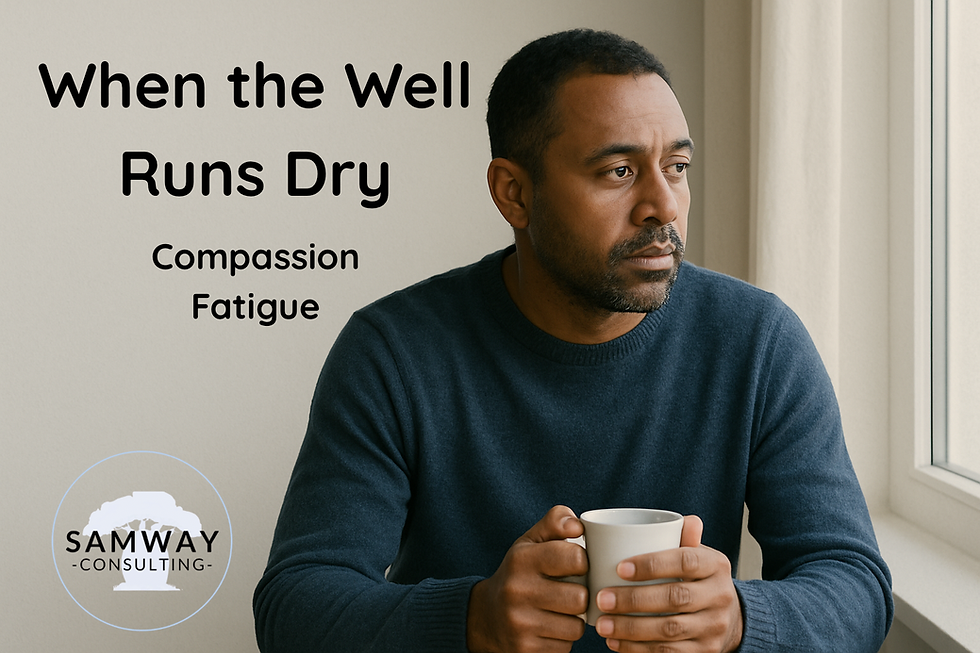How to Ground Yourself When You Feel Overwhelmed by Anxiety
- Wayne George

- May 17
- 3 min read

Have you ever felt so anxious that your mind was racing, your heart pounding, and everything around you felt far away?
That’s what overwhelm does. It hijacks your nervous system and disconnects you from the present moment.
Grounding is a practical way to come back to yourself. It won’t make the anxiety magically disappear—but it can anchor you in the here and now, so you can breathe, think, and move forward.
Here’s a step-by-step guide to help.
Step 1: Notice the Signs of Overwhelm
Start by recognising what’s happening. Anxiety often shows up as:
Racing thoughts
Tight chest or shallow breathing
Feeling disconnected or “not here”
Numbness or tingling
Sweaty palms or a knot in your stomach
Once you name it, you can begin to tame it.
Step 2: Say to Yourself, “I’m Safe Right Now”
Your body needs reassurance.
Try placing your hand on your chest and saying gently:
“I’m safe. I’m okay. I can get through this.”
Even if it feels mechanical at first, this simple statement can begin to calm your nervous system.
Step 3: Use the 5-4-3-2-1 Grounding Technique
This sensory-based tool brings you back into the present by tuning into your environment:
5 things you can see (Look around the room or out a window)
4 things you can feel (The chair under you, your feet on the ground, fabric on your skin)
3 things you can hear (Traffic, birds, a ticking clock)
2 things you can smell (Your shirt, tea, essential oil)
1 thing you can taste (A mint, water, gum)
Move slowly through each sense. Breathe as you go.
Step 4: Ground Through Your Body
Anxiety lives in the body, so use your body to settle it.
Try any of the following:
Stretch – Raise your arms high and take a deep breath.
Stamp – Press your feet firmly into the ground.
Hold – Squeeze a grounding object (stone, coin, textured item).
Press – Push your palms together or against a wall.
These actions remind your body that you are here, now—and safe.
Step 5: Focus on the Breath
Breathing is the fastest way to signal safety to your brain.
Try this simple Box Breathing technique:
Inhale for 4 seconds
Hold for 4 seconds
Exhale for 4 seconds
Hold for 4 seconds
(Repeat 3–5 times)
Imagine tracing the sides of a square as you breathe.
Step 6: Reflect Gently
Once the intensity has passed, check in with yourself.
What do I need right now?
Is there someone I can talk to?
What’s one small step I can take?
Write it down if it helps. Don’t pressure yourself for big answers. Just focus on one gentle step forward.
For Those with a Faith Background
If faith is part of your life, you might find grounding through short prayers, scripture, or sacred rhythms. Even whispering a verse like “Be still and know that I am God” (Psalm 46:10) can create a moment of stillness and connection. Repeating a comforting line or simply pausing to breathe in God’s presence can become an anchor during anxious moments. This isn’t about performance—it’s about presence.
When to Use Grounding
Grounding can help:
When you feel anxious or panicky
After a tough conversation or situation
Before bed if your thoughts are racing
During a triggering memory
When you feel emotionally “numb” or disconnected
Final Thought
You don’t need to wait for a crisis to ground yourself. The more you practise, the easier it becomes to access calm when you need it most.
Grounding isn’t weakness—it’s wisdom. It’s one way to say: I’m choosing peace, even when feels uncertain.
Need more support?
At Samway Consulting (formerly Samway Counselling Services), we support people just like you learn to manage anxiety, find clarity, and feel more steady in daily life.
Reach out today for confidential counselling, or explore our resources to support your mental health journey.






Comments